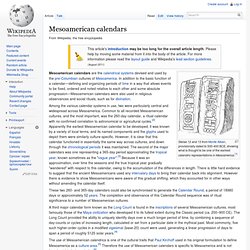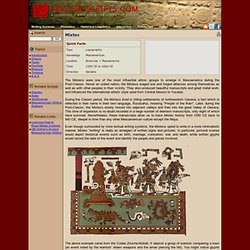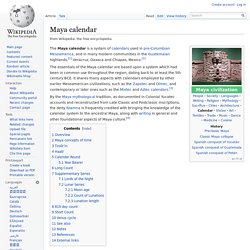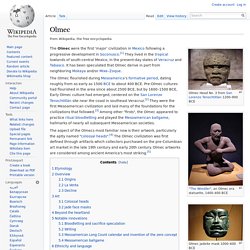

Mesoamerican calendars. Stelae 12 and 13 from Monte Alban, provisionally dated to 500-400 BCE, showing what is thought to be one of the earliest calendric representations in Mesoamerica.[1] Mesoamerican calendars are the calendrical systems devised and used by the pre-Columbian cultures of Mesoamerica.

In addition to the basic function of a calendar—defining and organizing periods of time in a way that allows events to be fixed, ordered and noted relative to each other and some absolute progression—Mesoamerican calendars were also used in religious observances and social rituals, such as for divination. Among the various calendar systems in use, two were particularly central and widespread across Mesoamerica. These two 260- and 365-day calendars could also be synchronised to generate the Calendar Round, a period of 18980 days or approximately 52 years. The completion and observance of this Calendar Round sequence was of ritual significance to a number of Mesoamerican cultures. Ritual 260-day calendar[edit] Mixtec. The Mixtecs were one of the most influential ethnic groups to emerge in Mesoamerica during the Post-Classic.

Never an united nation, the Mixtecs waged war and forged alliances among themselves as well as with other peoples in their vicinity. They also produced beautiful manuscripts and great metal work, and influenced the international artistic style used from Central Mexico to Yucatan. During the Classic period, the Mixtecs lived in hilltop settlements of northwestern Oaxaca, a fact which is reflected in their name in their own language, Ñuudzahui, meaning "People of the Rain".
Later, during the Post-Classic, the Mixtecs slowly moved into adjacent valleys and then into the great Valley of Oaxaca. This time of expansion is no doubt recorded in a large number of deerskin manuscripts, only eight of which have survived. Even though surrounded by more textual writing systems, the Mixtecs opted to write in a more minimalistic manner. The above example came from the Codex Zouche-Nuttall. ZAPOTEC 260 DAY CALENDAR.
Maya calendar. The Maya calendar is a system of calendars used in pre-Columbian Mesoamerica, and in many modern communities in the Guatemalan highlands,[1] Veracruz, Oaxaca and Chiapas, Mexico.[2] The essentials of the Maya calendar are based upon a system which had been in common use throughout the region, dating back to at least the 5th century BCE.

It shares many aspects with calendars employed by other earlier Mesoamerican civilizations, such as the Zapotec and Olmec, and contemporary or later ones such as the Mixtec and Aztec calendars.[3] By the Maya mythological tradition, as documented in Colonial Yucatec accounts and reconstructed from Late Classic and Postclassic inscriptions, the deity Itzamna is frequently credited with bringing the knowledge of the calendar system to the ancestral Maya, along with writing in general and other foundational aspects of Maya culture.[4] Overview[edit] The Maya calendar consists of several cycles or counts of different lengths.
Maya concepts of time[edit] Olmec. Olmec jadeite mask 1000–600 BCE The Olmec were the first 'major' civilization in Mexico following a progressive development in Soconusco.[1] They lived in the tropical lowlands of south-central Mexico, in the present-day states of Veracruz and Tabasco.

It has been speculated that Olmec derive in part from neighboring Mokaya and/or Mixe–Zoque. The Olmec flourished during Mesoamerica's formative period, dating roughly from as early as 1500 BCE to about 400 BCE. Pre-Olmec cultures had flourished in the area since about 2500 BCE, but by 1600–1500 BCE, Early Olmec culture had emerged, centered on the San Lorenzo Tenochtitlán site near the coast in southeast Veracruz.[2] They were the first Mesoamerican civilization and laid many of the foundations for the civilizations that followed.[3] Among other "firsts", the Olmec appeared to practice ritual bloodletting and played the Mesoamerican ballgame, hallmarks of nearly all subsequent Mesoamerican societies. Etymology[edit] Overview[edit] Art[edit]